Highlights and Attempts
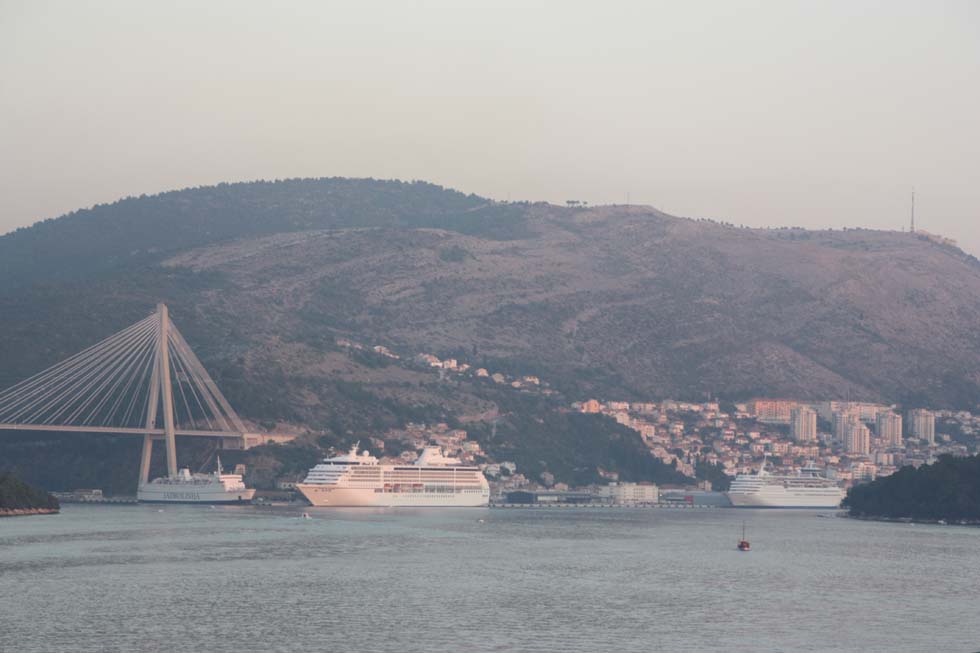 “Seven Seas Mariner” of Regent Seven Seas Cruises, on the right “Louis Olympia”, on the left a Jadrolinija ferry, Dubrovnik 2013 (Anton Soelch)
“Seven Seas Mariner” of Regent Seven Seas Cruises, on the right “Louis Olympia”, on the left a Jadrolinija ferry, Dubrovnik 2013 (Anton Soelch)
Though passengers aboard the mainstream megaships have every luxury imaginable, there are a few companies classified as “ultraluxury”, employing fleets of “all-outside-cabin” ships, listed by ShipPax and Frommer’s: Crystal Cruises, Regent Seven Seas Cruises, Sea Dream Yacht Club, Seabourn Cruise Line and Silversea Cruises. These companies have fares at least twice the rate asked for a comparable cabin aboard the famous QM2. Their market share is less than 5%. It’s a steadily changing market and therefore, without any prejudice, it is not possible to mention all of them. For Royal Viking Line with its luxury ships, then taken over by Kloster, and for Fred. Olsen Cruise Line, which acquired some of these ships, see the chapter Norwegian and Kloster.
Nippon Yusen Kaisha and Crystal Cruises
Traditional Nippon Yusen Kaisha (NYK) of Japan, founded in 1885 and then being described as world’s largest cargo shipping company, had abandoned passenger transport after WWII. It was not before 1988 that NYK of the Mitsubishi Group founded a cruise company, Crystal Cruises, based at Los Angeles in consideration of the USA’s dominating market position. With the “Crystal Harmony” (48,621 gt), built by Mitsubishi, they entered the ultraluxury market in 1990, followed by the “Crystal Symphony” (51,044 gt), delivered by Kvaerner Masa Yards in 1995, and the “Crystal Serenity” (68,870 gt) with pod propulsion, delivered by Chantiers de l’ Atlantique in 2003. Already the “Crystal Harmony” was praised for her comfortable cabins, designed by Studio Garroni, the Silk Road restaurant of the “Crystal Serenity” was styled by Tokyo architect Shinichi Okada and the Sushi Bar menus are inspired by Japanese master chef Nobu Matsuhisa. Cruises are worldwide and in 2005 the company hinted at a future new ship.
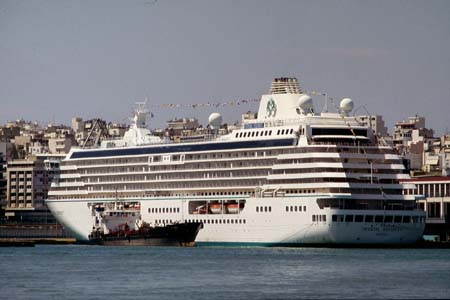
“Crystal Serenity” of Crystal Cruises, Piraeus 2009 (WS)
|
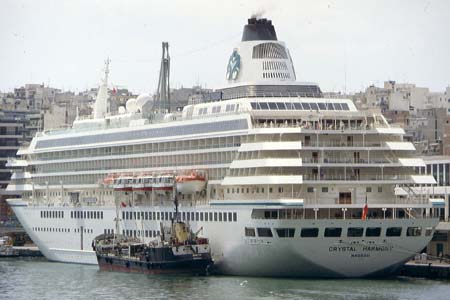
“Crystal Harmony”, the later “Asuka II”, Piraeus 1993 (WS)
|
NYK Cruises of Nippon Yusen Kaisha entered the Japanese market in 1991 with the “Asuka” (28,717 gt), built by Mitsubishi. In 2006 the company extended that business by transferring the larger “Crystal Harmony” to NYK Cruises as “Asuka II”. The first “Asuka” was chartered to Phoenix Reisen as “Amadea”.
Other Japanese Enterprises
The mighty Mitsui OSK started even round-the-world tours with the second “Nippon Maru” (1990/ 21,903 gt). The ferry company Shin Nihonkai owned the “Orient Venus” of Japan Cruise Lines, which was sold to Delphin Kreuzfahrten (see chapter German Tradition). Cruises, marketed as Venus Cruise, continued with the 26,594-ton “Pacific Venus” of 1998.

“Nippon Maru”, Mitsui OSK (advertisement)
|
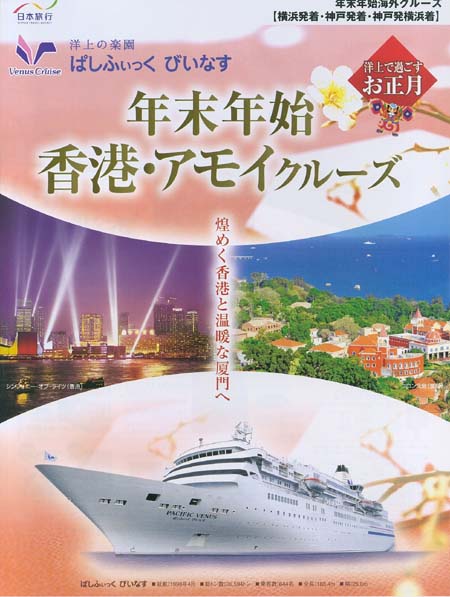
“Pacific Venus”, Venus Cruise (advertisement)
|
Regent Seven Seas Cruises
In 1992 Diamond Cruises and Radisson Hotels International had introduced the “Radisson Diamond”, an 18,400 gt SWATH twin-hull vessel. In 1997 she was registered for Radisson Seven Seas Cruises, but with a speed of only 12.5 knots too slow, she was sold in 2005 to become the casino ship “Asia Star” at Hong Kong. With the “Seven Seas Navigator” (2001/28,550 gt) as well as the pod-driven “Seven Seas Mariner” (2001/48,075 gt) and the “Seven Seas Voyager” (2003/41,500 gt) an exclusive fleet was built up, cruising worldwide, while the chartered “Paul Gauguin (1997/19,170 gt) of Grand Circle was based in Polynesia. In 2006 the company, owned by the Carlson Group, was rebranded Regent Seven Seas Cruises, then taken over by Apollo Management.
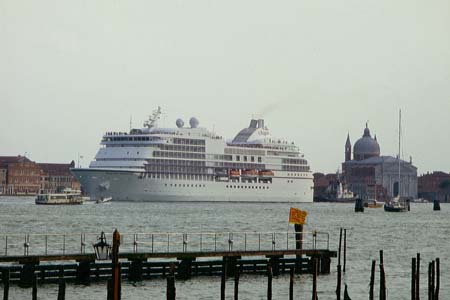
“Seven Seas Navigator”, Regent Seven Seas Cruises, Venice 2007 (WS)
|
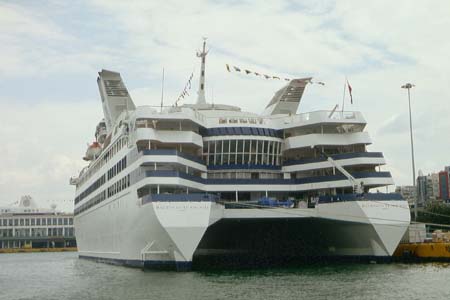
“Radisson Diamond”, Radisson Seven Seas Cruises, Piraeus 2004 (WS)
|
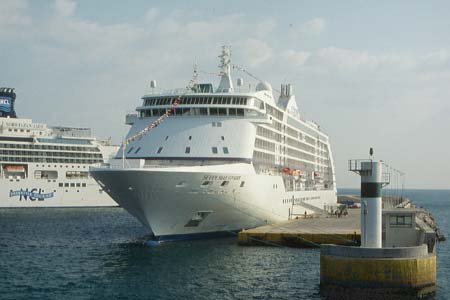
“Seven Seas Voyager”, Regent Seven Seas Cruises, Piraeus 2008 (WS)
|
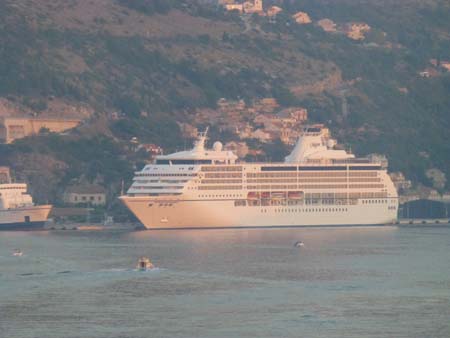
“Seven Seas Mariner”, Regent Seven Seas Cruises, Dubrovnik 2013 (Anton Soelch)
|
Seabourn Cruise Line
That company, founded by Norwegian entrepreneur Atle Brynestad in 1987 and acquired by the Carnival Corporation in 1991, got its reputation with the vessels “Seabourn Pride”, “Seabourn Spirit” and “Seabourn Legend” of less than 10,000 tons. From 2009 tours in connection with the nostalgic de-luxe train ‘Venice Simplon-Orient-Express’ (started in 1982 by James Sherwood) were offered. In 2009 the first among new 32,000 gt midsize ships, the “Seabourn Odyssey”, was delivered, followed by sister ships.
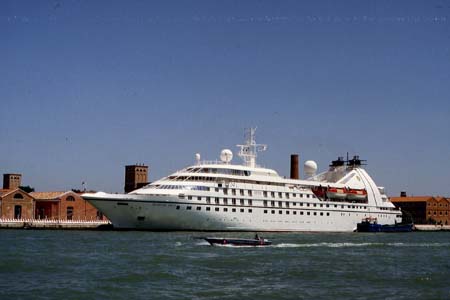
“Seabourn Spirit”, Venice 2009 (WS)
|
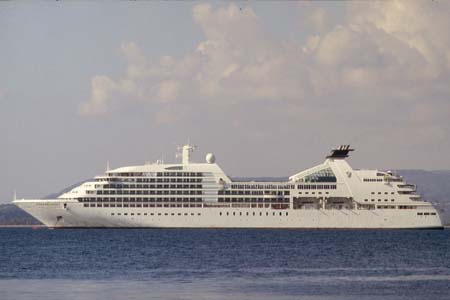
“Seabourn Odyssey”, Pylos, Peloponnese 2010 (WS)
|
Silversea Cruises
With that ultraluxury brand, the story of the famous Sitmar Line continued. Frommer’s informed: “Silversea Cruises was conceived in the early 1990’s by the Lefebvre family of Italy, former owners of Sitmar Cruises…”. Ships Monthly (April 2007) delivered additional details: “Sitmar Line was started by a Russian émigré, Alexandre Vlasov. Although Sitmar was acquired by P&O in 1988, the family involvement in cruise shipping continues today. Silversea was formed by Boris Vlasov, son of Alexandre Vlasov, and Professor Antonio Lefebvre d’ Ovidio, scion of a wealthy Italian family.” For cruising worldwide, the “Silver Cloud” (16,927 gt) was followed by other vessels. During a G8 summit, the “Silver Cloud” lay at St. Petersburg as a hotel afloat, serving UK Prime Minister Tony Blair, French president Jaques Chirac and German chancellor Gerhard Schroeder. Under chairman Manfredi Lefebvre d’Ovidio the company extended its exclusive offers with land excursions aboard the ‘Venice Simplon-Orient-Express’, the ‘East & Oriental Express’ from Singapore, the ‘Royal Scotsman’ or a tour to Florence by driving a Ferrari.
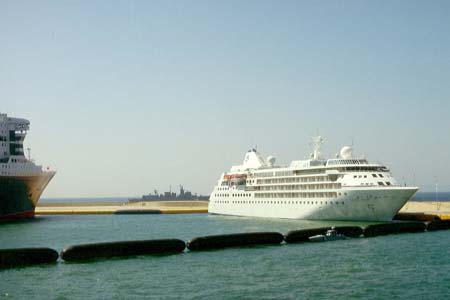
“Silver Wind” at Piraeus in 2004 on occasion of the Prince of Denmark visiting the Olympics, supervised by the Navy
|

“Silver Shadow”, Sai Gon downstream, Vietnam 2013 (WS)
|
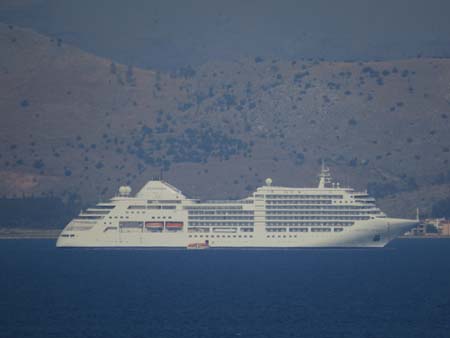
“Silver Spirit”, Nafplion, Peloponnese 2013 (WS)
|
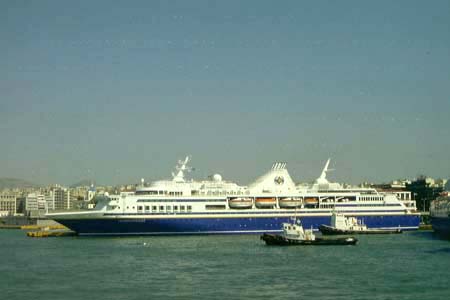
“Olympia Voyager” of Royal Olympia Cruises, Piraeus 2003 (WS)
|
Royal Olympic Cruises
This Greek company of the mainstream segment was, apart from Cunard, the only one which introduced new cruise ships with a speed of 30 knots, intended for reaching more destinations in seven days. The cruise pioneering company Epirotiki Lines of the Potamianos family together with Sun Line Cruises of the late Haralabos Keusseglou, former vice-president of Home Lines, had founded Royal Olympic Cruises in 1995, from 1999 in cooperation also with Louis Cruise Line. They added to their aged fleet the nice “Olympia Voyager” (24,391 gt) in 2000 and her sister “Olympia Explorer” in 2001, both built by Blohm & Voss for a speed up to 30.5 knots. The company however, then Royal Olympia Cruises, was bankrupt in 2004. The first of the fast vessels became the “Grand Voyager” of Iberojet Cruzeros and the second one was taken over by the Institute of Shipboard Education, established in 1977 by C.Y. Tung of Hong Kong, renamed “Explorer”.
Ponant Cruises
The Compagnie des Iles du Ponant, a French enterprise, is remarkable for having started in 1991 with the sailing-vessel “Le Ponant”. In 2004 the container giant CMA CGM took a 70% share. The company entered the media when “Le Boreal” was introduced in 2010, followed by sisters of only 10,700 tons each, built by Fincantieri, striking by their yacht-style appearance and their cool, modern interior design.
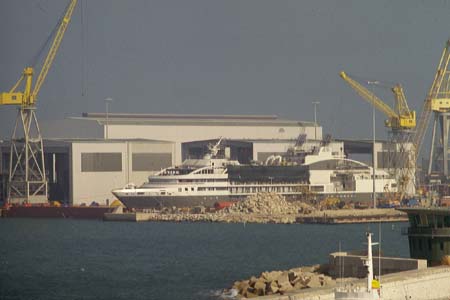
“Le Boreal” under completion for Ponant, Ancona 2009 (WS)
|
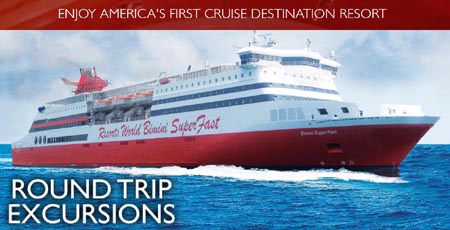
“Bimini SuperFast”, ex “Superfast VI” (Resorts World Bimini SuperFast homepage)
|
Bimini SuperFast
A new way of cruising to the booked holiday resort was opened by the Genting International Group (compare the chapters Norwegian, Star Cruises) by offering cruise ferry trips from Miami to Bimini Island of the Bahamas. It was reported (by Ferries) that the U.S. Coast Guard delayed the start until 20 July 2013, when the “Bimini SuperFast” could depart – the former “Superfast VI” (2001/32,728 gt), one of the Superfast Ferries’ speedrunners of Greece.
Ships for Charter
A description of the exclusive boats for charter of course cannot be a subject of this survey. But it is worth mentioning the “Savarona”, formerly the yacht of Turkish President Kemal Ataturk, later offered for charter and renamed “Istanbul”. She had been built in 1931 by Blohm & Voss for an American lady, Mrs. Emely Roebling-Cadwalladec, described as the largest private yacht of the epoch.
Most famous became the “Christina O”. The Canadian convoy escort “Stormont”, built in 1943, was bought in 1954 by successful shipowner Aristoteles Onassis. Rebuilt and renamed “Christina O”, she became his floating mansion. Among his many prominent guests was Maria Callas, the ‘Primadonna Assoluta’ of the opera houses. And a celebrated wedding reception was held aboard the “Christina O”: Onassis to widow Jackie Kennedy. After Aristoteles Onassis’ death in 1975, daughter Christina donated the yacht to the Greek government. Then bought by a family friend, she became offered to charter by Moody Yachts France at 45,000 to 65,000 euro per day.
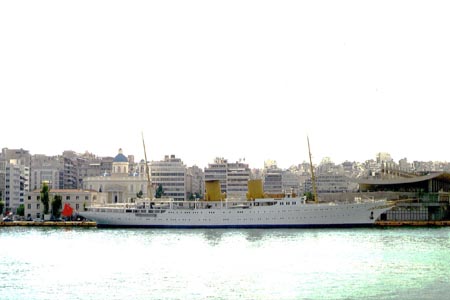
“Istanbul”, the former “Savarona”, Piraeus 2005 (WS)
|
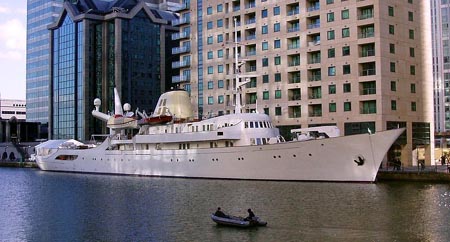
“Christina O” at Canary Wharf, London 2012 (Amy Reinolds, via Wikimedia)
|
Moored Resorts
“The ship is the destination”, wrote the Financial Times, describing the amenities offered aboard the cruising megaships. Unfortunately enough, historic ships permanently moored on a quay as floating resorts and centers of nostalgia proved commercially problematic. The “Queen Mary” (I) at Long Beach, California, is the most prominent example. Obviously the ship is not the only destination.
Homes Afloat
In 1977 Knut Utstein Kloster Jnr, son of cruise shipping pioneer Knut Kloster (see chapter Norwegian and Kloster) had planned the first ship to become the private home for people who want to buy or rent an apartment aboard a ship. In 1985 the press published his project of a 250,000 gt “floating structure”, the silhouette giving passengers a fantastic view. The design idea could be changed, resembling some island cities spread over pyramid-shaped hills, like Hermoupolis of Syros (a principle proposed by the author already in 1970 within an architectural competition). Assembling this ‘city’ aboard a ship would be a fascinating task for naval architects, difficult in consideration of stability problems. Excursion boats would dock inside the mother ship’s hull. With a length of 380 meters, the “Phoenix World City” of the World City Corp. AS should have got a capacity of 5,600 passengers. According to World City director Peter V. Uberroth, she “will be just the first ship of a new generation of floating holiday resorts which will revolutionize cruising and tourism industry during the next years” (published by tz, 15 July 1988). Finally the project had to give way to a single midsize ship. Ships Monthly reported: “In the mid-1990s, Knut Kloster Jnr identified a niche in the market for a condominium-style cruise ship. This original concept of a large 85,000-tonner was scaled down to a ship half the size”. Accommodating 198 suites, the all-white “The World” of 43,188 gt started round-the-world-tours for ResidenSea in 2002 - as the sole apartment ship afloat.
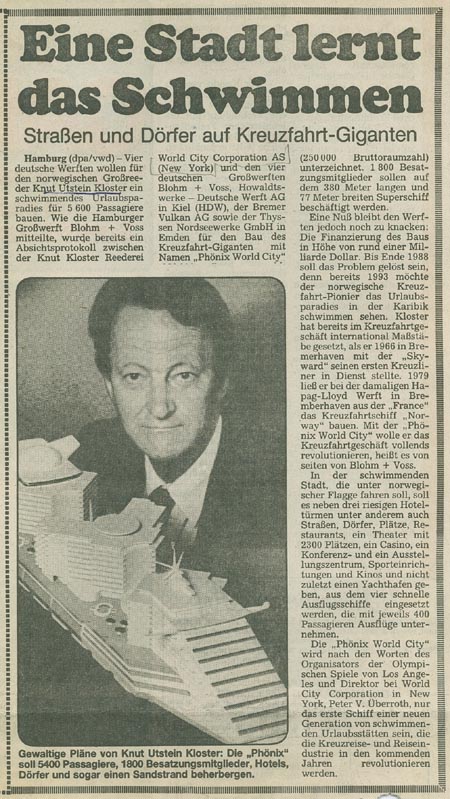
Knut Utstein Kloster and his project “Phoenix World City” (tz, 15 July 1988)
|
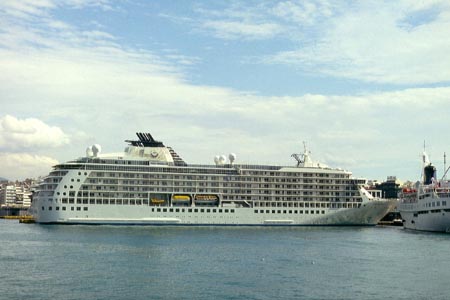
“The World”, ResidenSea, Piraeus 2007 (WS)
|
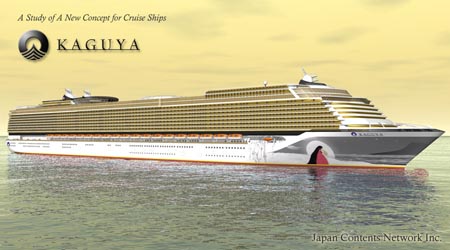
“Princess Kaguja” project (main_photo, via Wikimedia)
|
|
Also other projects emerged in the USA, Canada or elsewhere. In 2007 Japan Contents Network published the “Princess Kaguya” project of a gigantic 450,000 gt condominium-style ship, 505 metres long, laid out for 8,400 passengers and a speed of 22 knots. It was designed by Aker Yards, representing its ‘Scandinavian’ style. The Web site announced that “it will be fully available to the people it visits at each port of call, functioning as an international cultural exchange”. The plan of building the ship for completion in 2012 did not come true – but it’s a fascinating idea.
Fantasy...
Jules Verne had published the science fiction vision of a ship 7 km long, powered by a one-million hp engine, laid out for (only) 10,000 passengers, surely billionaires. An idea, not quite as megalomaniac, was born with the project of another visionary, being published in 1998: For millionaires no longer willing to spend their money for an own yacht, the “Freedom Ship”, laid out at 2.7 million gt and an estimated price of about 11 billion dollars, equipped with 20,000 apartments and an aircraft deck, was conceived by engineer Norman Nixon. It was to become the floating refuge of a sole upper class to take them round the world in west-eastern direction every two years. A n-tv report of February 2007 commented: “…. Skeptics do not believe in the success of the ‘Freedom Ship’”. But fantasy knows no limits...
A different idea, rather macabre, had been published in 1981: An American insurance company announced to have a 75,000-ton imitation of the “Titanic” built for 600 passengers willing to pay at least 1000 dollars per night for a trip following the disastrous course of the original “Titanic”. Another dream was published in 2012: The Australian multi-millionaire Clive Palmer announced his intention of ordering the “Titanic II” with a Chinese shipyard, to enter service in 2016 on a route from England to New York.
Adventure Cruising
For enthusiasts, exotic cruise voyages aboard small ships are offered by a few companies. The North West Passage, the North Pole and the Antarctic waters have become the most exciting destinations. US-based Quark Expeditions got famous for the most adventurous journeys. This enterprise had been founded in 1991 by Lars Wikander of Sweden. He arranged to charter the Russian nuclear-powered “Sovetskiy Soyus”, a black/red icebreaker of 20,646 gt, for a voyage to the North Pole. His company Quark Expeditions continued chartering Russian icebreakers for Arctic cruises. Kludas listed the nuclear-powered “Sovetskiy Soyus”, her sister “Yamal”, and diesel-powered icebreakers on charter for several western companies. In 2007 First Choice Cruises acquired Quark Expeditions. The “World Discoverer” of Discoverer Reederei, built in 1974, was the first real passenger ship which undertook the voyage from the Atlantic to the Pacific by the way of the North West Passage in 1988. Then TV showed a trip of the “World Discoverer” to the grave of Shackleton and the icy Antarctic Paradise Bay. Among the companies which started traveling to the Antarctic is Hurtigruten, the traditional Norwegian coastal mail line, with the “Fram”. And after we met an American couple who had undertaken a world-circumnavigation on their own sailing yacht and then praised enthusiastically an Antarctic voyage on a cruise ship, we were impressed from that ultimate dream of traveling to undiscovered miracles.
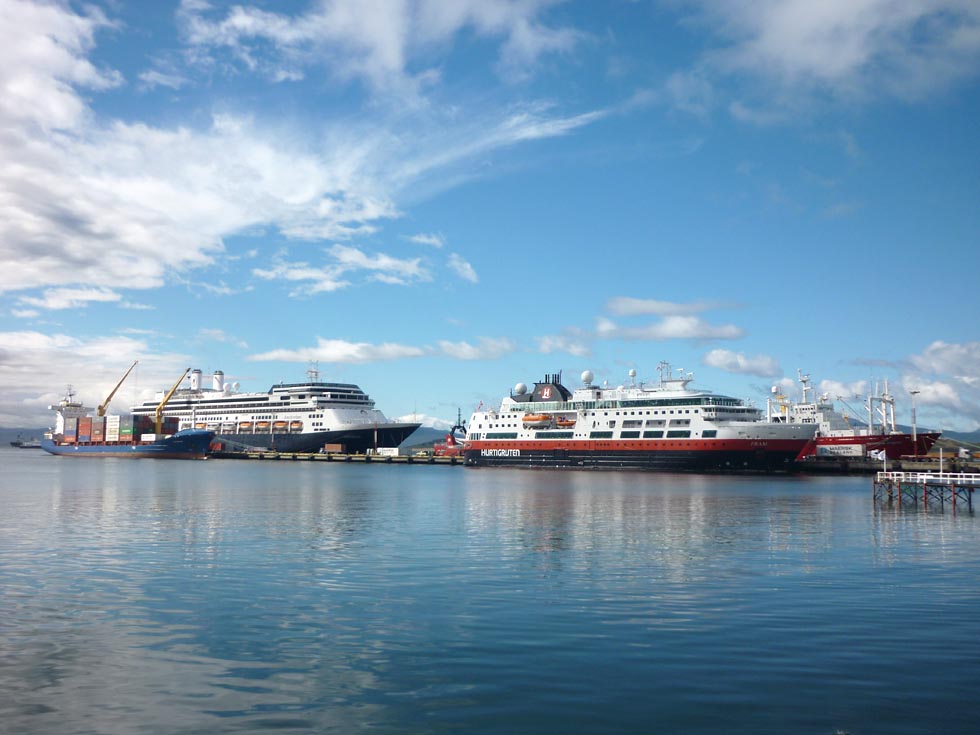
“Fram” of Hurtigruten, on the left “Amsterdam” of Holland America Line at Ushuaia, Argentina 2013 (Hermann Willenbrock)
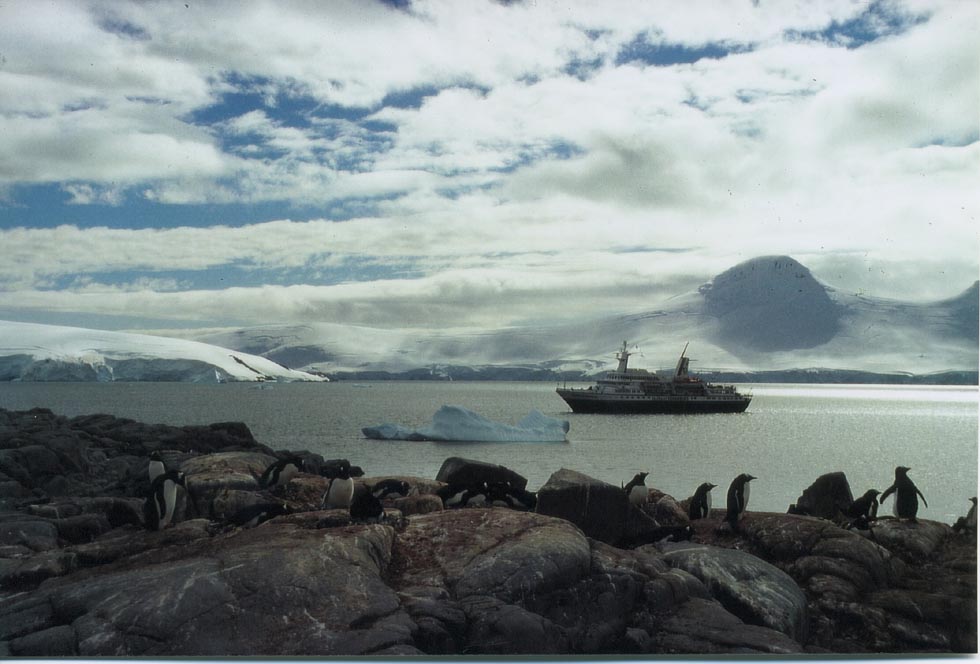
“World Discoverer” of Discoverer Reederei at Port Lockroy, Antarctic, 1988 (Margit Orthgiess)
|